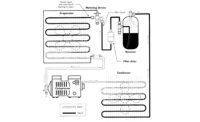Inexperienced service technicians have a tendency to add refrigerant to a troubled system in order to remedy a problem. Because of this, many systems are operating with an overcharge of refrigerant. These overcharged systems run very inefficiently and often end up with more serious overheating problems in the near future.
Below are the symptoms for an overcharged refrigeration system that incorporates a refrigerant receiver after the condenser and a TXV for the metering device. These symptoms are divided into low- and high-side symptoms for ease of analysis and can be applied to any refrigerant:
High-side symptoms:
- High discharge temperature;
- High condenser subcooling;
- High condensing pressures; and
- Higher condenser splits
Low-side symptoms:
- Normal-to high-evaporator pressures; and
- Normal superheats
The following checklist shows a refrigeration system with an overcharge of refrigerant. The system is a medium-temperature TXV/receiver system with R-134a as the refrigerant:
| Measured values: | |
| Compressor discharge temperature | 240°F |
| Condenser outlet temperature | 90°F |
| Evaporator outlet temperature | 30°F |
| Compressor inlet temperature | 40°F |
| Ambient temperature | 70°F |
| Box temperature | 35°F |
| Low-side (evaporator) pressure | 8.8 psig (20°F) |
| High-side (condensing) pressure | 172 psig (120°F) |
| Calculated values: | |
| Condenser split | 50°F |
| Condenser subcooling | 30°F |
| Evaporator superheat | 10°F |
| Compressor superheat | 20°F |
System Analysis
With an overcharged system, the high compressor discharge temperature of 240°F is caused by the high compression ratio. A discharge temperature of 225°F to 250°F is considered the maximum discharge temperature in order to prevent system breakdown from excessive heat.
Higher-than-normal head pressures are caused by liquid backed up in the condenser from the overcharge of refrigerant, which will flood some of the condenser’s internal volume at its bottom. All of the heat being absorbed in the evaporator and the suction line, along with the compressor motor heat and high heat of compression from the high compression ratio, has to be rejected into a smaller condenser’s internal volume because of the excessive backed-up liquid refrigerant in the condenser.
Because of the excess amount of refrigerant in the system, the condenser will have too much liquid backed up at its bottom, causing high condenser subcooling. Remember, any liquid in the condenser that is lower than the condensing temperature is considered subcooling. This can be measured at the condenser outlet with a thermometer or thermocouple. Simply subtract the condensing outlet temperature from the condensing temperature to get the amount of liquid subcooling in the condenser.
A forced air condenser used in refrigeration should have at least 6°F to 8 °F of liquid subcooling in the condenser. However, subcooling amounts depend on system piping configurations and liquid line static and friction pressure drops. Condenser subcooling is an excellent indicator of the system's refrigerant charge: The lower the refrigerant charge, the lower the subcooling, and the higher the refrigerant charge, the higher the subcooling.
As mentioned earlier, subcooled liquid backed up in the condenser will cause a reduced condenser internal volume and raise condensing pressures. Once the condensing pressures are raised, there is more of a temperature difference between the surrounding ambient and the condensing temperature, causing greater heat flow. This compensates for the reduced condenser’s internal volume. The system will still reject heat, but at a higher condensing pressure and temperature.
Because of the higher condensing pressures and thus higher condensing temperatures, there will be a greater temperature difference (split) between the ambient and condensing temperature. A dirty condenser will also give a system high condenser splits, but the condenser subcooling will not be as high as with an overcharged system. Remember, the condenser split is the difference between the condensing temperature and the ambient temperature.
The condenser flooded with liquid during the overcharge will run high condensing pressures. This causes high compression ratios and low volumetric efficiencies, resulting in low refrigerant flow rates.
Since this system has a TXV metering device, the TXV will still try to maintain its evaporator superheat, and the evaporator pressure will be normal to slightly high depending on the amount of overcharge. If the overcharge is excessive, the evaporator's higher pressure would be caused by the decreased mass flow rate through the compressor from high compression ratios, causing low volumetric efficiencies. The evaporator would have a harder time keeping up with the higher heat loads from the warmer entering-air temperature. The TXV will also have a tendency to overfeed refrigerant to the evaporator on its opening stroke due to the high head pressures.
The TXV will try to maintain superheat even at an excessive overcharge; however, once the pressure ranges of the TXV valve have been exceeded, it may overfeed during its opening strokes and could do damage to the compressor. Again, it all depends on the severity of the overcharge of refrigerant and the corresponding elevated head pressures.
If the system has a capillary tube metering device, the same symptoms occur with exception of the evaporator superheat. Remember, capillary tube systems are critically charged to prevent liquid floodback of refrigerant to the compressor during low evaporator loadings. The higher head pressures of an overcharged system with a capillary tube will have a tendency to overfeed the evaporator, thus decreasing the superheat. If the capillary tube system is severely overcharged, liquid can enter the suction line and get to the suction valves or crankcase. This will cause compressor damage and eventually failure.
Remember, it is the detailed system check that will tell the service technician whether or not a system is overcharged. Service technicians must always install pressure gauges and thermistors or some other sort of temperature sensing devices in order to correctly and systematically troubleshoot a refrigeration system.








